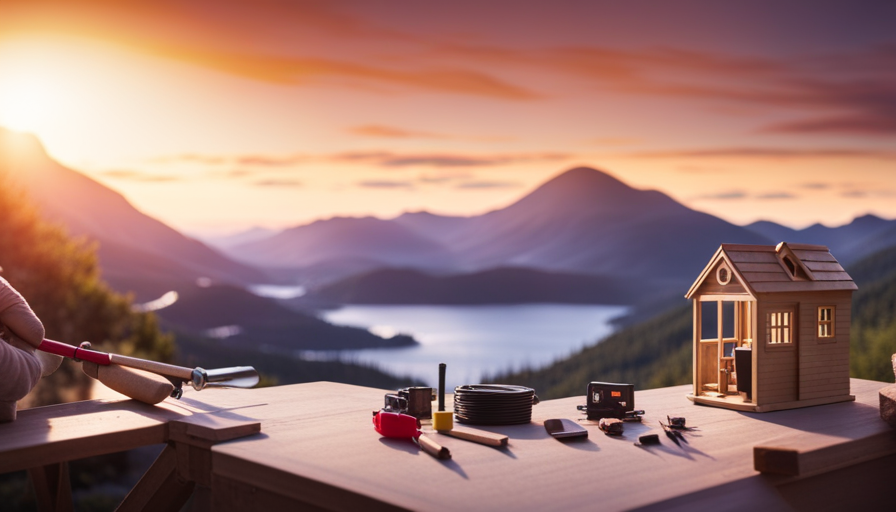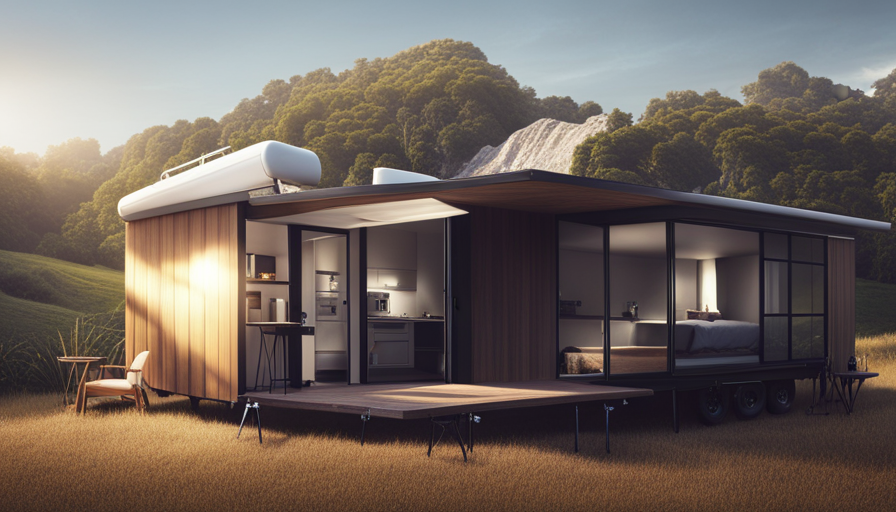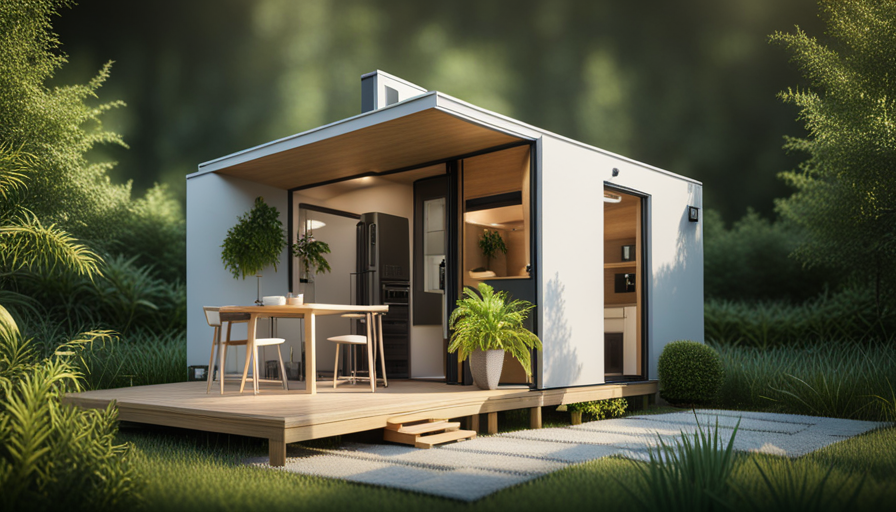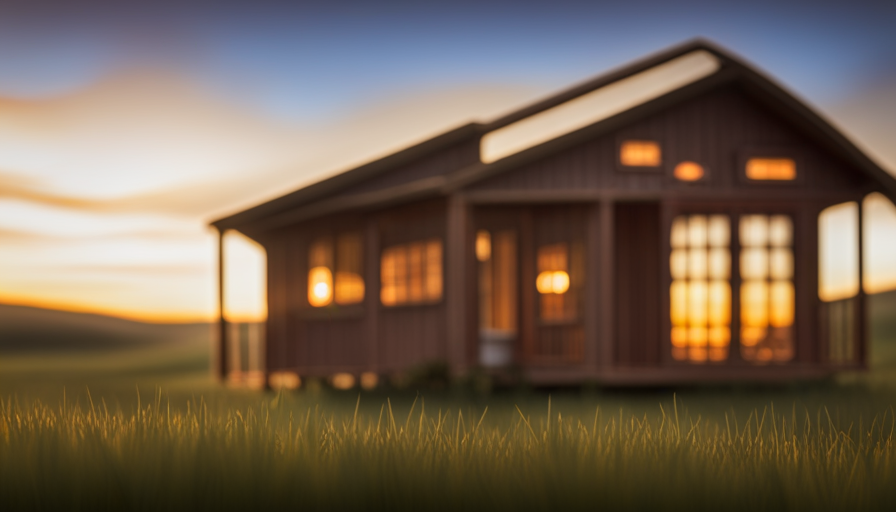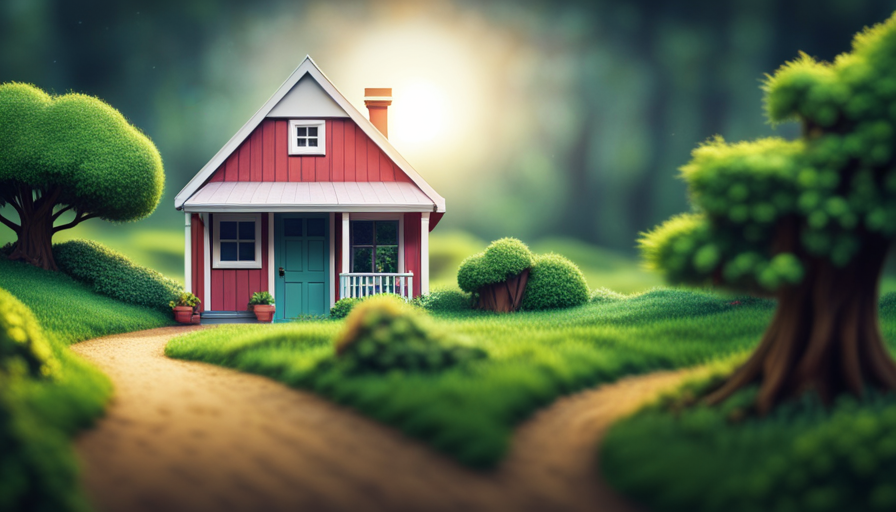Starting the process of building my own tiny house was both exciting and a little nerve-wracking. Like many others who have taken on this project, I had dreams of creating a cozy and eco-friendly home that would suit me perfectly.
However, as I delved into the planning and design stage, I quickly realized that building a tiny house is no small feat.
According to recent data, the average time it takes to build a tiny house from start to finish is around 400 hours. That’s roughly equivalent to spending 17 full days non-stop! But fret not, because with careful organization and efficient construction methods, you can significantly reduce this timeline.
In this article, we will explore the step-by-step process of building a tiny house, from gathering materials to final inspections. By following these guidelines and dedicating your time and effort, you’ll be able to transform your dream into reality in no time.
So let’s dive in and discover just how many hours it takes to create your very own slice of heaven!
Key Takeaways
- Building a tiny house takes an average of 400 hours.
- The construction process involves planning, design, and construction stages.
- Design considerations include natural lighting, airflow, insulation, storage solutions, and energy efficiency.
- Electrical and plumbing installations should be done by professionals, considering placement of outlets, switches, and lighting fixtures.
Understand the Planning and Design Stage
The planning and design stage is where I’ll start brainstorming ideas and creating the blueprint for my dream tiny house. This is a crucial step in the process as it sets the foundation for everything that follows. During this stage, I will carefully consider various design options and weigh them against my specific needs and preferences.
The planning process involves taking into account factors such as layout, size, materials, and budget. It’s important to think about how each decision will impact the overall functionality and livability of the tiny house.
Design considerations are also an essential part of this stage. I need to think about how each element of the house will work together harmoniously. This includes considering things like natural lighting, airflow, insulation, storage solutions, and energy efficiency. Additionally, I’ll need to ensure that the design meets all necessary building codes and regulations.
Once the planning and design stage is complete, I can move on to gathering materials and equipment needed for construction. By carefully considering every aspect of the planning process and making informed design decisions, I can ensure that my tiny house will be a perfect reflection of my vision while also meeting all practical requirements.
Gather Materials and Equipment
Once you’ve rounded up all the necessary materials and equipment, it’s like gathering the pieces of a puzzle that’ll eventually come together to create your cozy little sanctuary.
To ensure a smooth construction process, gathering supplies and selecting tools are crucial steps in building a tiny house.
Here are three items you’ll need to gather:
-
Lumber: This is the backbone of your tiny house. Choose high-quality lumber that’s strong and durable to provide stability and support for your structure.
-
Insulation: Proper insulation is essential for maintaining a comfortable temperature inside your tiny house. Look for insulation materials that offer good thermal resistance and soundproofing qualities.
-
Plumbing fixtures: Depending on your design, you may need to gather plumbing fixtures such as sinks, toilets, and showers. Opt for efficient fixtures that conserve water without compromising functionality.
When it comes to selecting tools, having the right ones can make a world of difference in efficiency and precision during construction. Some essential tools include:
-
Circular saw: Perfect for cutting precise angles in wood quickly.
-
Cordless drill: Ideal for drilling holes or driving screws without restrictions from cords.
-
Level: Ensures that everything is straight and level during installation.
With all your supplies gathered and tools selected, you’re now ready to begin construction on your dream tiny house.
Begin Construction
Get started on constructing your cozy little sanctuary by diving into the exciting world of building. Beginning construction is an exhilarating process that requires careful planning and attention to detail.
The construction process involves several key steps that will bring your tiny house dreams to life.
First, you’ll need to prepare the foundation for your tiny house. This includes leveling the ground and ensuring a solid base for your structure.
Once the foundation is ready, it’s time to start framing your walls and roof. This step requires precision and accuracy to ensure a sturdy and secure structure.
Next, you’ll move on to installing windows and doors. This not only adds functionality but also allows natural light to flood into your space, creating a warm and inviting atmosphere.
Insulation comes next, helping regulate temperature inside your tiny house.
After insulation, it’s time for interior finishes such as drywall or paneling. These materials give your tiny house a polished look while making it feel like a home.
Finally, finish off with exterior siding or cladding.
As you complete the beginning stages of construction, you can start envisioning how electrical and plumbing installation will fit into the overall design of your cozy abode.
Continue reading about electrical and plumbing installation in the next section without skipping a beat!
Electrical and Plumbing Installation
Now you’re ready to bring your cozy sanctuary to life by diving into the exciting world of electrical and plumbing installation. This step is crucial in ensuring that your tiny house is not only functional but also safe and efficient.
When it comes to electrical wiring, it’s important to hire a professional or consult with an expert who can guide you through the process. They’ll help you determine the right placement for outlets, switches, and lighting fixtures. Remember to plan ahead and consider any additional appliances or electronics you might want in your tiny house.
As for plumbing fixtures, there are several options available depending on your needs and preferences. You can choose between traditional plumbing systems or opt for more eco-friendly alternatives like composting toilets or greywater recycling systems. Ensure that all pipes are properly insulated to prevent freezing during colder months.
To emphasize some key points:
- Hire a professional for electrical wiring.
- Plan ahead for outlets, switches, and lighting fixtures.
- Consider additional appliances or electronics.
- Choose between traditional plumbing systems or eco-friendly alternatives.
With these installations complete, you’re one step closer to enjoying your dream tiny house. The next section will focus on interior finishing touches that’ll truly make this space feel like home.
Interior Finishing
To truly transform your cozy sanctuary into a personalized haven, let’s delve into the world of interior finishing and add those special touches that will make this space feel like home.
When it comes to interior decor ideas for your tiny house, the key is to optimize the limited space you have. One effective technique is to use multifunctional furniture pieces that serve more than one purpose. For example, a sofa that can also be converted into a bed or storage ottomans that can double as seating.
Another way to maximize space is by utilizing vertical storage solutions such as wall-mounted shelves and hanging organizers. These not only save floor space but also provide an opportunity to display personal items and add character to your tiny house.
Additionally, incorporating mirrors strategically throughout the space can create an illusion of depth and make it appear larger.
When selecting colors and patterns for your interior finishes, opt for light shades that reflect natural light and create an airy atmosphere. Neutral tones with pops of color in accent pieces can also help bring life into the space without overwhelming it.
By implementing these interior decor ideas and space optimization techniques, you can turn your tiny house into a functional yet stylish retreat.
Now, let’s move on to the next section about exterior finishing and landscaping where we will explore ways to enhance the outer appeal of your cozy abode.
Exterior Finishing and Landscaping
Revamp the exterior of your cozy sanctuary and create a picturesque landscape that will make your tiny house stand out in the neighborhood. First impressions matter, so investing time and effort into exterior finishing and landscaping is essential for creating an inviting atmosphere. By incorporating elements such as exterior decorating and garden design, you can transform your tiny house into a charming oasis.
To help you visualize the possibilities, here is a table showcasing different ideas for exterior finishes and landscaping:
| Exterior Finishing | Garden Design |
|---|---|
| Painted siding | Flower beds |
| Cedar shingles | Potted plants |
| Stone veneer | Herb garden |
By carefully selecting these elements, you can achieve a cohesive and visually appealing look for your tiny house. Whether you prefer a rustic cabin feel or a modern aesthetic, there are countless options to choose from when it comes to exterior finishes.
Now that we have covered the importance of exterior finishing and landscaping, let’s move on to the next step: installing utilities. Creating a functional living space involves ensuring that all necessary amenities are properly installed within your tiny house.
Install Utilities
Installing utilities in your cozy sanctuary involves ensuring that all necessary amenities are properly incorporated into the functional living space of your tiny house. This process can be challenging due to various utility installation challenges and the cost associated with it. However, with careful planning and execution, you can successfully integrate utilities into your tiny house.
Here are some important considerations when installing utilities in your tiny house:
-
Electrical wiring: Ensuring that your tiny house has a reliable electrical system is crucial. This includes installing circuit breakers, outlets, and light fixtures.
-
Plumbing system: Incorporating a plumbing system requires careful placement of pipes for water supply and waste disposal. Additionally, consider installing a water heater and bathroom fixtures to make your living space more convenient.
-
Heating and cooling systems: Depending on your location’s climate, you may need to install heating or cooling units to maintain a comfortable temperature inside your tiny house.
-
Internet and communication infrastructure: In today’s connected world, having access to the internet is essential. Consider installing Wi-Fi routers or running Ethernet cables for reliable connectivity.
Despite the challenges and costs involved in utility installation, it’s an important step towards making your tiny house fully functional. Once these installations are complete, you can move on to adding those final touches and inspections before enjoying the comfort of your new home.
Final Touches and Inspections
When it comes to the final touches and inspections of a tiny house, there are three key points that need to be addressed.
First, I’ll install lighting fixtures and appliances to ensure that the house is fully functional and ready for use.
Next, I’ll conduct final inspections and tests to make sure that everything is in working order and meets all necessary standards.
Lastly, I’ll ensure compliance with building codes to guarantee the safety and legality of the tiny house.
By focusing on these key points, I can confidently complete the construction process and prepare for a successful move-in.
Install Lighting Fixtures and Appliances
To make your tiny house feel cozy and functional, it’s essential to add lighting fixtures and appliances. Here are some trends in lighting fixtures that can enhance the aesthetic appeal of your tiny home:
- Pendant lights: These stylish fixtures hang from the ceiling, providing both ambient and task lighting.
- LED strip lights: These versatile lights can be installed under cabinets or along walls to create a warm and inviting ambiance.
- Skylights: Adding skylights not only brings in natural light but also provides a sense of openness and connection with nature.
- Smart lighting systems: With these systems, you can control the brightness, color, and timing of your lights using smart devices.
In addition to choosing the right lighting fixtures, incorporating energy-efficient appliances is crucial for a sustainable tiny house. Opt for appliances with Energy Star ratings to minimize energy consumption.
Now that we’ve installed our lighting fixtures and appliances, it’s time to conduct final inspections and tests to ensure everything is functioning properly.
Conduct Final Inspections and Tests
Now that you’ve completed the installation of your lighting fixtures and appliances, it’s time for you to conduct final inspections and tests to ensure everything is functioning properly. This step is crucial in ensuring the safety and efficiency of your tiny house.
Start by conducting thorough inspections of all electrical connections, making sure there aren’t any loose wires or faulty connections. Check each lighting fixture and appliance individually, turning them on and off to make sure they’re working correctly.
Additionally, perform tests on the electrical panel to verify that all circuits are properly labeled and functioning as intended. Pay close attention to any abnormal sounds, smells, or overheating during this process.
Once you’ve finished conducting inspections and performing tests, you can proceed to the next section about ensuring compliance with building codes by verifying that all electrical work meets local regulations.
Ensure Compliance with Building Codes
Ensuring compliance with building codes is essential for the safety and legal integrity of your project. It ensures that all electrical work meets local regulations and standards. Building codes are put in place to protect occupants and ensure structural stability.
To ensure compliance, it’s important to thoroughly review the building codes specific to your area and consult with professionals if needed. This includes understanding requirements for insulation, foundation, plumbing, electrical systems, and more.
Adhering to these codes may require additional time and resources, but it’s crucial for a successful tiny house build. By ensuring compliance with building codes, you can have peace of mind knowing that your tiny house meets all necessary safety standards.
Moving forward into the next phase of "move-in and enjoy," you can confidently embark on making your tiny house a comfortable home.
Move-In and Enjoy
Get ready to move into your brand new tiny house and start enjoying the cozy, minimalist lifestyle you’ve always dreamed of! After completing the construction and ensuring compliance with building codes, it’s time for the exciting move-in process.
Begin by organizing your belongings and carefully placing them in their designated spots. Utilize clever storage solutions to maximize space efficiency and keep everything tidy.
Once all your essentials are in place, it’s time to add personal touches. Get creative with decorating ideas that reflect your unique style and make the space feel like home. Consider using multi-functional furniture that serves both practical purposes and adds aesthetic appeal.
Now that you have settled into your tiny house, it’s important to transition smoothly into maintenance and upkeep. Regularly inspect the structure for any signs of wear or potential issues. Keep a checklist of routine tasks such as cleaning filters, checking electrical connections, and maintaining plumbing systems. By staying on top of these tasks, you can ensure that your tiny house remains in optimal condition for years to come.
With the move-in complete and maintenance underway, you’re now ready to fully embrace the joys of living in a tiny house while relishing its simplicity and charm.
Maintenance and Upkeep
To keep your tiny house in excellent condition, it’s crucial for you to regularly inspect the structure and perform necessary maintenance tasks. For example, imagine you notice a small leak in the plumbing system; by promptly addressing the issue and fixing it, you can prevent further damage and ensure a comfortable living environment.
Maintenance and upkeep are essential aspects of owning a tiny house. Regularly checking for any signs of wear and tear is important to catch problems early on before they escalate into costly repairs. This includes inspecting the roof for leaks or damage, checking the siding for any cracks or loose panels, and testing all electrical systems to ensure they’re functioning properly.
In addition to regular inspections, performing routine maintenance tasks is necessary to keep your tiny house running smoothly. This may include cleaning out gutters, changing air filters, lubricating hinges and locks, and sealing any gaps or cracks in windows and doors. Properly maintaining appliances such as HVAC systems, water heaters, and kitchen appliances also contributes to their longevity.
When estimating the cost of maintenance and upkeep for your tiny house, it’ll vary depending on factors such as size, materials used in construction, location climate conditions, and personal preferences. However, it’s generally recommended that homeowners set aside around 1-2% of their home’s value each year for these expenses.
By staying diligent with regular inspections and performing necessary maintenance tasks on your tiny house, you can extend its lifespan while minimizing potential repair costs. Ensuring that everything’s in good working order will provide you with peace of mind, knowing that your cozy abode remains a safe haven.
Frequently Asked Questions
What are the key factors to consider during the planning and design stage of building a tiny house?
During the planning and design stage of building a tiny house, there are several key factors to consider.
One important factor is space utilization, which involves carefully planning the layout and ensuring maximum use of every square inch. This can be achieved by incorporating storage solutions and multi-purpose furniture that optimize limited space.
Functionality is another crucial factor to consider. The design should prioritize practicality and convenience, taking into account the specific needs and lifestyle of the occupants.
Aesthetics also play a significant role in the planning and design stage. Creating a visually appealing and cohesive space is important for comfort and enjoyment.
In addition to these factors, attention should be given to energy efficiency, ventilation, and natural lighting. These aspects contribute to the overall comfort and sustainability of the tiny house.
Lastly, personal preferences and lifestyle needs should be taken into consideration. Design choices should reflect the individual’s tastes and requirements, resulting in a well-designed and comfortable tiny house.
Where can I find the necessary materials and equipment for building a tiny house?
When it comes to finding the necessary materials and equipment for building a tiny house, there are several options available.
Hardware stores like Home Depot and Lowe’s offer a wide range of building materials such as lumber, insulation, and wiring.
Online retailers like Amazon also have a variety of tiny house kits that include all the essential materials needed for construction.
Additionally, local classifieds or salvage yards can be great sources for finding affordable used building equipment.
What are the first steps to take when beginning construction on a tiny house?
First steps in beginning construction on a tiny house involve planning, design, and obtaining necessary permits.
I would start by creating a detailed floor plan to determine the layout and dimensions of the house.
Next, I would gather all required materials and equipment for construction.
Obtaining any necessary permits from local authorities is also essential before starting the actual construction process.
The timeline for completing a tiny house varies based on complexity but generally takes several weeks to a few months.
What are some important considerations when it comes to electrical and plumbing installation in a tiny house?
When it comes to electrical and plumbing installation in a tiny house, two crucial factors to consider are electrical safety and plumbing regulations.
Ensuring proper electrical safety measures can prevent hazardous situations such as fires or electrocution.
Adhering to plumbing regulations is essential for maintaining water quality and preventing leaks or contamination.
By prioritizing these aspects, you can create a safe and functional living space while complying with necessary standards.
How can I effectively maintain and upkeep my tiny house to ensure its longevity?
To ensure the longevity of my tiny house, effective maintenance is crucial. I prioritize regular inspections to identify any issues early on. This includes checking for leaks, inspecting the foundation, and maintaining the HVAC system.
Cleaning and decluttering regularly helps prevent damage and improve air quality. Additionally, I stay proactive with exterior maintenance like painting and sealing to protect against weather damage.
By implementing these practices, I can extend the lifespan of my tiny house and enjoy it for years to come.
Conclusion
In conclusion, building a tiny house is an intricate process that requires careful planning and attention to detail. Just like constructing a home, it symbolizes the creation of a haven where one can find solace and comfort.
From gathering materials to installing utilities, each step plays a vital role in bringing this dream to life. While it may take several hours or even days to complete, the end result is worth the effort.
So, roll up your sleeves and embark on this exciting journey towards creating your own cozy sanctuary!
Hi, I’m Emma. I’m the Editor in Chief of Tiny House 43, a blog all about tiny houses. While tree houses are often associated with childhood, they can be the perfect adult retreat. They offer a cozy space to relax and unwind, surrounded by nature. And since they’re typically built on stilts or raised platforms, they offer stunning views that traditional homes simply can’t match. If you’re looking for a unique and romantic getaway, a tree house tiny house might just be the perfect option.
